Back to index
Reviews of Books On KAP
Updated October 2008
Books on KAP are somewhat hard to find. In fact books on kites in general
are not available at my local bookstores, which otherwise have a good stock.
Most of mine came from the Kite Lines Bookstore or the bookshop.kiteaerialphotography.net. I would like to offer my reviews
of these books as an aid to others trying to find or buy books on KAP. If
anyone who reads this has some book I don't list, or has a review of their
own, I'd be delighted to hear from them. Contact me at
charles.p.hall@gmail.com.
Click on the images to see full-size pictures of the covers.
The Aerial Eye. Originally published four times a year from the fall of
1994 through the summer of 1999. 5½x8½". About 25 pages per issue,
18 issues.
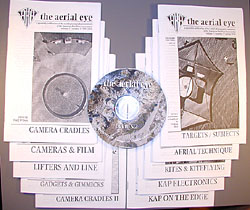 The absolute best source of information on KAP is the The Aerial Eye.
This now defunct periodical is still available from the magazine's editor,
Brooks Leffler via email or on the web
at bookshop.kiteaerialphotography.net
or the KAPER site.
Currently he sells a complete set of 18 issues on a CD-ROM in Adobe Acrobat format for $30.
The absolute best source of information on KAP is the The Aerial Eye.
This now defunct periodical is still available from the magazine's editor,
Brooks Leffler via email or on the web
at bookshop.kiteaerialphotography.net
or the KAPER site.
Currently he sells a complete set of 18 issues on a CD-ROM in Adobe Acrobat format for $30.
This collection is just superb.
The magazine was so good it appears to have drained the world-wide KAP
user community of ideas in its day and run out of material! The images on the CD-ROM,
while in color are very low resolution. The Acrobat format, is, well Acrobat, i.e. very
annoying and clumsy. The original small print format may be awkward to print from Acrobat.
But it's worth putting up with Acrobat for this, and don't miss the complete index in
the last issue!
(Oh, one final note, remember back in 1999 digital photography was in it's infancy. You'll
find mostly film cameras here.)
Kite Aerial Photography by Mark Cottrell, 1987. 8½" x 11", 44 pages.
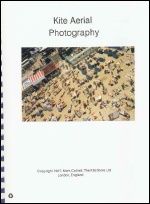 This spiral bound book has a single photo, the color photo pasted on to the front cover!
The text consists of typewritten pages and hand-drawn diagrams showing a variety of camera
rigs, most either pendulum types or types attached directly to the kite line. Guidelines
are included for selecting and making various kites, cameras, films and control mechanisms.
This spiral bound book has a single photo, the color photo pasted on to the front cover!
The text consists of typewritten pages and hand-drawn diagrams showing a variety of camera
rigs, most either pendulum types or types attached directly to the kite line. Guidelines
are included for selecting and making various kites, cameras, films and control mechanisms.
What sets this book apart from the rest is Cottrell's very knowledgeable advice on
a variety of very technical topics. For instance, this is the only book I've read
which discusses what size objects camera lenses of varying focal lengths can resolve
at different altitudes (e.g. a 12.5mm focal length lens can see a car at 2500
meters). He also discusses the advantages of the various camera formats, both
smaller and larger than 35mm. There is also a good discussion of what kites fly
best in what kinds of wind and how various camera rigs are affected.
Of course, it's age does show. There is no discussion of suspension rigs (like
Picavet), there is only speculation about digital cameras and the level
of detail on R/C servos is not really enough to be useful. However, after having
read it you will have a good feel for what physical factors affect kite
photography and what to expect.
This book is doubtless hard to find, but I got mine from the
Kite Lines Bookstore.
Aerial Photography By Kite by Raoul Fosset, 1994, published by the
Drachen Foundation. 8¼" x 11½",
13 pages, spiral bound. Price $5 US.
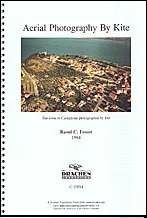 Fosset's little publication feels like a updated supplement to Cottrell's book.
It focuses on more current practices and goes into more detail than Cottrell.
My edition included a nice color-xerox photo on the front, while the rest of
the content consists of black & white photos and drawings. Fosset covers two
kites, Rokkaku and delta, a pendulum and simple suspension rig, R/C controlled
pan and tilt mechanisms, and 35 mm cameras. The drawings are clear but this is not
a step-by-step instruction book. The component brands are mostly European and
the American readers will have to find locally available equivalents for
things like Fischer Technik gears, a Robbe micro switch and a Graupner radio.
It also includes a bibliography which is basically a superset of Cottrell's.
Too bad so many of the books are in French, Dutch and Japanese!
Fosset's little publication feels like a updated supplement to Cottrell's book.
It focuses on more current practices and goes into more detail than Cottrell.
My edition included a nice color-xerox photo on the front, while the rest of
the content consists of black & white photos and drawings. Fosset covers two
kites, Rokkaku and delta, a pendulum and simple suspension rig, R/C controlled
pan and tilt mechanisms, and 35 mm cameras. The drawings are clear but this is not
a step-by-step instruction book. The component brands are mostly European and
the American readers will have to find locally available equivalents for
things like Fischer Technik gears, a Robbe micro switch and a Graupner radio.
It also includes a bibliography which is basically a superset of Cottrell's.
Too bad so many of the books are in French, Dutch and Japanese!
This publication should be readily available. I got mine from
bookshop.kiteaerialphotography.net.
It can also be purchased from the
Drachen Foundation.
"Aerial Photographs Taken From a Kite" by G. de Beauffort and M. Dusariez,
1995, KAPWA Foundation Publishing. 8¼ x 5¾'", 142 pages.
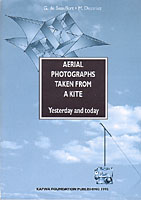 This book appears to be the only published legacy of the KAPWA organization.
Dusariez founded KAPWA in 1985 as an organization devoted solely to kite
aerial photography. For eight years a magazine was published four times a
year. The first 93 pages of this book consist of editted and organized reprints
of material that appeared in the magazine.
This book appears to be the only published legacy of the KAPWA organization.
Dusariez founded KAPWA in 1985 as an organization devoted solely to kite
aerial photography. For eight years a magazine was published four times a
year. The first 93 pages of this book consist of editted and organized reprints
of material that appeared in the magazine.
This is a wonderful book, with sections devoted to all the subjects KAP'ers
are interested in: Which kite? Which camera? How to trigger the shutter? The
answers to these and many other practical questions are addressed with clearly
written text and excellent illustrations. There are also a large number of
black & white photos, printed beautifully. Of course, having been written over
a decade ago there's no mention of digital photography. Also, the information
on R/C control is somewhat incomplete.
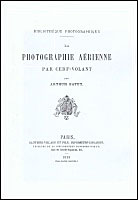 The last forty pages of the book are a special treat: an English translation
of Arthur Batut's 1890 text, La Photographie Aérienne par Cerf-Volant
(Aerial Photography by Kite)". In it Arthur Batut (the father of kite aerial
photography) describes step by step how to build a camera, build a kite, attach
the camera, fly it, fire it and develop the film! Back then it was all do-it-yourself.
The writing and the translation are excellent and this in-depth view of the early
days is just fascinating. (Note: a picture of Batut's kite is on the cover of Serge
Negre's book.)
The last forty pages of the book are a special treat: an English translation
of Arthur Batut's 1890 text, La Photographie Aérienne par Cerf-Volant
(Aerial Photography by Kite)". In it Arthur Batut (the father of kite aerial
photography) describes step by step how to build a camera, build a kite, attach
the camera, fly it, fire it and develop the film! Back then it was all do-it-yourself.
The writing and the translation are excellent and this in-depth view of the early
days is just fascinating. (Note: a picture of Batut's kite is on the cover of Serge
Negre's book.)
If you have a chance, buy this book! I got mine from the
Kite Lines Bookstore in Sept. 2001 and
it's on the web at the
bookshop.kiteaerialphotography.net.
"Vu du ciel (Eye in the sky)" by Serge Negre, 1999, published by
Société d'études et de Recherches Archéologiques
et Historiques de Labruguière.
9½" x 8¼",
60 pages. US$ 19.95.
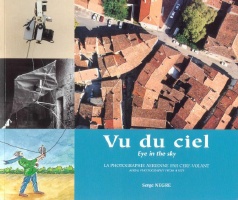
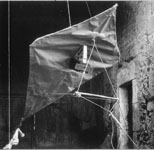
Batut's kite, from the cover |
This beautiful little book is illustrated with color photos and drawings on
almost every page. The text, in both French and English, describes the author's
fascination with aerial photography and details on kites and a pendulum-type
camera rig. Although few specifics are given, the razor sharp photos of his
rig and the clear text show exactly how it all works together. The last half
of the book is a collection of Negre's photos, including shots from his
arctic expeditions and pictures of the town of Labruguiere. Labruguiere
was the home of Arthur Batut, the father of kite photography.
If the book has a failing, it is that the reader is left yearning for more
details about Batut, since the author mentions having met his great granddaughter
and being inspired upon finding Batut's kite in the attic!
Available from the Kite Lines
Bookstore and the
bookshop.kiteaerialphotography.net.
Photographie Aérienne Avec Cerf-Volant by Christian Becot, 1995, published
by C. Becot, 108 Rue Médéric, 50110, Tourlaville, France.
8¼" x 11½", 52 pages. Color cover with B&W illustrations throughout. In French.
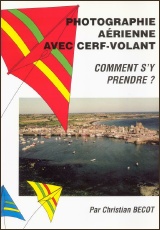 This book by regular Aerial Eye contributor Christian Becot looks like it would be
very interesting... if I could read French! He compares Picavet vs. pendulum rigs, as well
as explaining both mechanical and electronic shutter-release techniques. There are also
many drawings of kites and variety of interesting stabilization devices I haven't seen
before. He also introduces an alternative suspension to Picavet, by G. Lawrence.
This book by regular Aerial Eye contributor Christian Becot looks like it would be
very interesting... if I could read French! He compares Picavet vs. pendulum rigs, as well
as explaining both mechanical and electronic shutter-release techniques. There are also
many drawings of kites and variety of interesting stabilization devices I haven't seen
before. He also introduces an alternative suspension to Picavet, by G. Lawrence.
Despite the hand-drawn diagrams, I believe that if you read French there would be sufficient
information here to build some of these novel devices. I hope that Christian will come
out with an English language edition of this book. Available from the
Kite Lines Bookstore and the
bookshop.kiteaerialphotography.net.
Airborne Camera, by Beaumont Newhall, 1969, published by Hastings House Publishers, NY.,
8½x10", 144 pages, many B&W photos.
 This book differs from the other books on this page in that it is not exclusively about
Kite Aerial Photography, and it is long out of print. The author, Beaumont Newhall, director
at the George Eastman House from 1958-1971, has written other works about the history
of photography, but this book appears to be a labor of love. He gives a detailed history
of photography from the air, first by balloon, then from kites, rockets, pigeons and finally
aircraft and spacecraft. What sets this book apart from other general histories is that he
includes copious photographs and drawings from those very early years. The first 48 pages
describe aerial photography prior to airplanes, with photos on virtually every page. Despite
only having five pages on kites, he covers Batut, Eddy and George Lawrence including facts
I haven't seen elsewhere. Pages 49-64 cover the early days of photography from airplanes, which
I also found interesting. He describes many applications for aerial photography (such as
aerchaeology) which are within the reach of modern KAP'ers. The last half of the book covers photography
from space, via both satellite and manned spacecraft. Much of this last material is dated
enough to be obsolete, but not yet old enough to be interesting.
This book differs from the other books on this page in that it is not exclusively about
Kite Aerial Photography, and it is long out of print. The author, Beaumont Newhall, director
at the George Eastman House from 1958-1971, has written other works about the history
of photography, but this book appears to be a labor of love. He gives a detailed history
of photography from the air, first by balloon, then from kites, rockets, pigeons and finally
aircraft and spacecraft. What sets this book apart from other general histories is that he
includes copious photographs and drawings from those very early years. The first 48 pages
describe aerial photography prior to airplanes, with photos on virtually every page. Despite
only having five pages on kites, he covers Batut, Eddy and George Lawrence including facts
I haven't seen elsewhere. Pages 49-64 cover the early days of photography from airplanes, which
I also found interesting. He describes many applications for aerial photography (such as
aerchaeology) which are within the reach of modern KAP'ers. The last half of the book covers photography
from space, via both satellite and manned spacecraft. Much of this last material is dated
enough to be obsolete, but not yet old enough to be interesting.
This book may be found by searching used bookstores on the internet on sites such as
ABE Books, a worldwide consortium of private booksellers.
If you find it, it will cost less than the new books, I can assure you!
Labruguiere, birthplace of kite aerophotography, Arthur Batut 1846-1918
by Danielle Autha, Serge Negre, Geoffroy de Beauffort, Raoul Fosset. 1988,
published by Midi France Communication. 6¾" x 9¼". 155 pages. Price
$14.95. Text in both French and English.
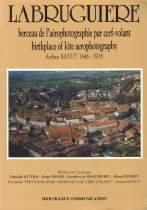
This is a difficult book to review. While there is much to like about the book, it
also has flaws. The good news first, this book has a wealth of early KAP
photos not to be found elsewhere. In fact there are 27 aerial photos by Arthur
Batut (and his friends), and 27 more of street scenes in Labruguiere, where Batut lived
and worked. The authors obtained a wealth of information on Arthur Batut and his
pioneering kite photography from descendents living in the town, and from material
collected for a museum dedicated to him. The book is rounded out by seven modern
color KAP photos and six more modern B&W photos. There are also eight photos of
Batut's equipment and four more of modern rigs.
The bad news is that the English translation is very rough, and sometimes you're not
quite sure what it means.
The last sixty pages of the book are devoted to Batut's own book, La Photographie
Aérienne par Cerf-Volant. A far better translation of Batut's book can be found in
the KAPWA publication above.
Fotograferende Vliegers, by Nop Velthuizen and Gerard Van Der Loo. 1988, published by Elmar,
7" x 8¾". 120 pages, hardback. Price $8.95. Heavily illustrated in B&W. Text in Dutch.
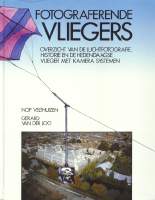
There have been several times in my life when I have wished I spoke Dutch. This is one of them!
The full translated title of this book is "Picture-taking kites; overview of aerial
photography, history and today's kite with camera-systems", and it does not lie. This book
covers a lot of territory.
As near as I can count it has 118 black & white drawings and photos. There are 30 images related
to balloon, rocket and pigeon aerial photography in the first few chapters. The following section
on Batut and his contemporaries has 22 images. 16 images are devoted to non-European KAP, plus
10 more to show various modern day scientific applications of KAP.
Modern KAP techinques are tackled in the next few chapters, with sections on camera rigs,
triggering methods, and R/C control. This particular area seems a little superficial, with no
mention of Picavet rigs, just pendulum hung film cameras. A nice chapter on
kite selection follows, a topic often glossed over in other KAP books.
The last pages interest me the most of all. Using photos and scale drawings of windmills the
authors give various geometric formulas for determining altitude, field of view, etc.
Despite it's small format and foreign language, I think this book deserves study even by
non-Dutch speakers. A little time with a dictionary would reveal much about the diagrams
and images. And those of you who speak Dutch have it made!
Hanging by a Thread, by Craig Wilson. 2006. Published by Itchy Cat Press. 8½ x 10½".
131 pages, paperback. Price $23.
(Available from Amazon)
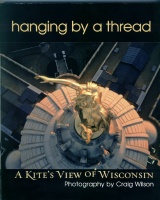
Sub-titled "A Kite's View of Wisconsin" this book has more than 140 pictures
of the lakes, rivers and cities of Wisconsin. There are stunning pictures of
sailboats in the summer, iceboats in the winter, majestic buildings, college
marching bands, etc. Each picture has a caption in English, Spanish, German,
and what appears to be Chinese. Interspersed with the pictures are brief essays
in English describing how he got some of the photos. There are precious
few details on his camera-rig, but otherwise this book is awesome.

 The absolute best source of information on KAP is the The Aerial Eye.
This now defunct periodical is still available from the magazine's editor,
Brooks Leffler via email or on the web
at bookshop.kiteaerialphotography.net
or the KAPER site.
Currently he sells a complete set of 18 issues on a CD-ROM in Adobe Acrobat format for $30.
The absolute best source of information on KAP is the The Aerial Eye.
This now defunct periodical is still available from the magazine's editor,
Brooks Leffler via email or on the web
at bookshop.kiteaerialphotography.net
or the KAPER site.
Currently he sells a complete set of 18 issues on a CD-ROM in Adobe Acrobat format for $30.











